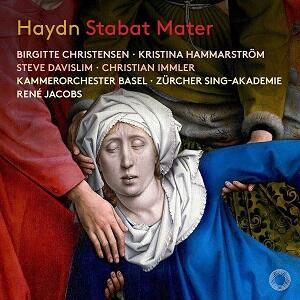
Joseph Haydn (1732-1809)
Stabat Mater (1767, enlarged wind orchestration version by Sigismund Neukomm, 1803)
Birgitte Christensen (soprano), Kristina Hammarström (alto), Steve Davislim (tenor), Christian Immler (bass)
Zürcher Sing-Akademie
Kammerorchester Basel/René Jacobs
rec. 2021, Paul Sacher Saal, Don Bosco, Basel, Switzerland.
Sung Latin texts with rhymed English and German translations enclosed.
Reviewed as download from press preview
Pentatone PTC5186953 [61]
Stabat Mater is a 13th century hymn to Mary, the mother of Jesus Christ, depicting her sufferings during the crucifixion. It has been set to music by many prominent composers, including Josquin des Prez, Orlande de Lassus, Palestrina, Vivaldi and Pergolesi. The latter’s setting, which was his swan song, became very popular and was the inspiration for the then still young Haydn when he in 1767 was commissioned by the Eszterházy family for their annual sacred concert on Good Friday in the Schlosskirche in Eisenstadt. Haydn had then been Vice-Kapellmeister at the court for some years and gradually taken over the duties from the ageing Kapellmeister Werner, with the exception of the sacred music, but in 1766 Wernerdied and Haydn, the natural heir to the Kapellmeister position, stepped in. This was his first major sacred work and was probably premiered on 17 April 1767, which was Good Friday that year. By sheer coincidence I listened to the present recording on Good Friday this year, which no doubt enhanced the spiritual experience of the music.
What the congregation in the Schlosskirche in Eisenstadt heard 256 years ago differs however quite a lot from René Jacobs and his forces offer on this recording. Haydn scored the music for four soloists, mixed choir, two oboes both doubling English horn in the sections in E-flat major, strings and organ continuo. Here, the work is performed in the version Haydn in 1803 commissioned his pupil Sigismund Neukomm to expand the orchestration – in close collaboration with the ageing composer. They added flute, two clarinets, bassoons, horns, trumpets, timpani and three trombones. This makes a great difference from the discreet scoring of the original – which in itself was lavish compared to normal, established Stabat Mater settings, where often only organ accompaniment was employed. Imagine a small jazz combo versus a big band. This pays dividends, not least in the two bass arias (tr. 5 & tr. 11) which are the dramatic highpoints. Overall, it makes the music grander, more extrovert and suited for concert purposes. It also alienates the music from its liturgical abode, but I wouldn’t say that it profanes the work. The basic mood is solemnity and grief – and there is melodious beauty that goes directly to the heart. I would unhesitatingly say that the two contralto arias (tr. 2 & tr. 9) belong to the most memorable moments, in particular the latter, Fac me vere tecum flere, is immensely gripping. The concluding parts, when we are approaching Paradise, are also filled with warmth and a faith in the future.
The performance is taut and committed. The Kammerorkester Basel is a well-known quantity, at home in the Baroque sphere as well as contemporary repertoire and anything in between. René Jacobs, now in his mid-seventies, started his career as a boy chorister and later became one of the foremost counter-tenors, before in the 1970s gradually changing over to conducting has, not surprisingly, special insight in the human voice and caters well for soloists as well as choristers. The four soloists are excellent. The Norwegian soprano Birgitte Christensen was a new name to me, although she has been active on the international circuit for most of this century. She has a beautiful lyric voice and sings with lightness of tone. Swedish contralto Kristina Hammarström has primarily been in the forefront of the international baroque elite for the last twenty years, and her smooth singing here is admirable. Malaysian-born Australian tenor Steve Davislim is also well established in the opera houses and recital halls worldwide. He has an ideally lyrical voice for this part and is also expressive. Some years ago I hailed Christian Immler for his outstanding singing of Heine songs (review), which was a Recording of the Month in January 2016. Here he executes the two dramatic bass arias with great fervour. Zürcher Sing-Akademie is well-drilled and homogenous in the choral movements. To sum up, this is a highly recommendable recording of a Stabat Mater with a special twist: the enlarged wind orchestration from 1803.
Göran Forsling
Help us financially by purchasing from





















